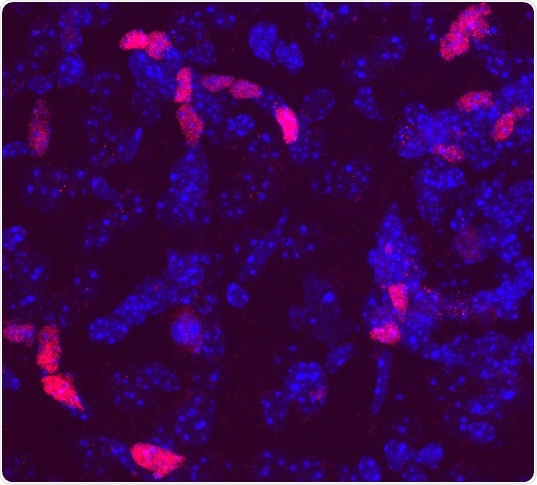A single protein may turn adult brain cells termed astrocytes into stem-like cells that create neurons and other cell types, according to UT Southwestern researchers. They recently published their study in the journal Proceedings of the National Academy of Sciences. The results might lead to a method of regenerating brain tissue following disease or injury in the future.

Stem-like cells (red) are generated from adult brain astrocytes. Image Credit: Zhang lab, UT Southwestern Medical Center.
We’re showing that it may be possible to reprogram the fate of this subset of brain cells, giving them the potential to rebuild the damaged brain.”
Chun-Li Zhang, Study Leader, Co-Corresponding Author and Professor, Molecular Biology, UT Southwestern Medical Center
Chun-Li Zhang is an investigator at Peter O’Donnell Jr. Brain Institute
Mammalian stem cells grow rapidly throughout development, producing neurons throughout the brain as well as supporting cells known as glia. Glia plays an important role in maintaining brain function by cleaning away waste and insulating nerve fibers.
The developed brain, on the other hand, loses much of its stem cell capability. Dr Zhang stated that the adult brain has just two tiny regeneration zones, or niches, leaving it with a very limited ability to repair itself after injury or disease.
Glia can be induced to create neurons in some types of brain damage or following genetic modification, according to recent studies. Although these discoveries are encouraging, Dr Zhang believes that repairing healthy brain tissue would need the development of several cell types rather than just neurons.
Dr Zhang and his colleagues employed a genetic engineering approach in adult mouse brains to drive astrocytes, a subgroup of glia, to express various transcription factors, proteins important for cell identity regulation while finding a way to spur the “multipotent” regeneration. These studies revealed that a single transcription factor, DLX2, appeared to transform astrocytes into neural stem-like cells capable of generating neurons and numerous glial cell subtypes.
The results were validated by lineage tracing, which involved following the progeny of the changed astrocytes as they multiplied, as well as marker analysis, which revealed that the new cells had the anticipated identities of neurons or glia.
Global gene expression analysis, headed by co-corresponding author Gary Hon, Ph.D., Assistant Professor of Obstetrics and Gynecology and in the Cecil H. and Ida Green Center for Reproductive Biology Sciences and the Lyda Hill Department of Bioinformatics, revealed that inducing DLX2 production in astrocytes appeared to reprogram them into stem-like cells.
These stem cells had characteristics of both immature brain cells found earlier in development and cells found in the regenerative space of the human brain.
Dr. Zhang and his colleagues propose that DLX2 might be utilized to treat traumatic brain injuries, strokes, and degenerative diseases like Huntington’s disease in the future. This strategy will be tested in animal models by Zhang lab researchers.
Source:
Journal reference:
Zhang, Y., et al. (2022) A single factor elicits multilineage reprogramming of astrocytes in the adult mouse striatum. Proceedings of the National Academy of Sciences. doi.org/10.1073/pnas.2107339119.